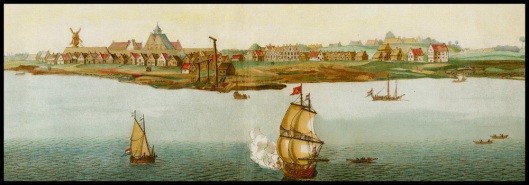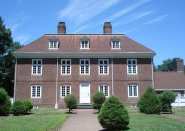William Penn adopted, at best, a paternalistic attitude towards black slaves ‘looking upon a slave not as the property of the master but as a member of the family’.
The immediate American association with William Penn and the Americas in many people’s mind is the State of Pennsylvania, but he was also involved in the bloody English annexation and the settlement by Quakers of the New York and New Jersey areas. These lands were already settled by slave-owning Europeans, a system of enforced labour which continued and was expanded during English rule.
As referred to in previous posts Penn was a close friend of the Duke of York (later James II). In 1664, the Duke was given the area of New Amsterdam (renamed New York in his honour) and beyond.

New Amsterdam (NYC Dept of Records)
Quakers were already established in the colony at Flushing and Oyster Bay. Previously, under the Dutch West India Company, the slaves of New Amsterdam had lived in what was known as ‘half-freedom’, that is to say they had some rights and some, limited, independence. However, once under British rule they became chattel slaves, i.e. perceived as personal property of the slave owners in a way that was different from previous slave-systems. It was slavery used as labour under an emerging and consolidating capitalism. Although it is worth noting that these urban slaves never accepted the complete servitude endured by their rural counterparts. None of this ever seemed to affect Quaker William Penn’s friendship with the Duke. By 1687 Quakers were extremely populous in the slave-based colony of New York. As Governor Dongon reported:
‘Here bee not many of the Church of England, (and) few Roman catholicks, [but] abundance of Quakers – preachers men and women, especially – singing Quakers, ranting Quakers, Sabbartarians, Anti sabbatarians, some Anabaptists, some Independents, some Jews; in short, all sorts of opinions there are some, and the most part none at all.’
The Quakers of Pennsylvania used euphemisms for their slaves referring to them as ‘servants’ and their labour as ‘service’. This makes it difficult to ascertain how many slaves the Penn family owned in Pennsylvania. In 1685, he wrote casually of his ownership of slaves of the use of slave labour for the transportation of goods through the colonies:
“ Let him have one of the blacks of Allen, two of which are as good as bought, such a one as is most used to sea…. “
Slave ownership was written into the first Frame of Government of the Province of Pennsylvania. Penn’s Quaker professions of equality and fair play counted for little or nothing once confronted with a rapidly growing province with an acute shortage of labour to work the lands and carry out the multitude of tasks demanded by rural and urban Quaker society. Wage labour at this time was difficult to obtain in a Pennsylvania where land was cheap and fertile and where credit was readily available. Quaker pragmatism therefore, demanded the labour of slaves.
Quakers dealt directly in trading slaves. James Claypool a Quaker and member of the Free Society of Traders had a joint business with other Quakers to buy slaves from his brother in Barbados. Penn’s agent, Philip Lehnmain, used a ship, The Isabella’, to trade for slaves. In 1683 Penn himself was actively dealing in slaves, buying a number from Captain Nathaniel Allen. Penn was also selling slaves. He sold one who was an excellent fisherman for ‘a full price, for the man will expect it of me‘.

Pennsbury Manor (reconstructed), Falls Township, Pennsylvania
Exactly how many slaves worked at the Pennsbury Mansion and Plantation (left) belonging to William Penn is not clear. They were numerous: two slaves, Yaffe and Chevalier, were mentioned as Penn’s favourite “servants” and a slave named Tish was the personal servant of Penn’s daughter, Letitia. Certainly, by 1687 Penn had decided that his plantation at Pennsbury should use only slave labour with a white overseer. In a letter from England to his agent in Philadelphia on this preference for slave labour over white indentured labour:
“It was better they was blacks for then a man has them while they live.”
Pennsbury was Penn’s country estate and mansion in Pennsylvania. It was referred to as his “palace”. As an aristocrat, Penn obviously thought that a slave plantation was the natural inheritance for his children when wrote of Pennsbury:
“Let my children be husbandmen and housewives. This leads to consider the works of God and nature and diverts the mind from being taken up with the vain arts and inventions of a luxurious world. Of cities and towns of concourse beware. The world is apt to stick close to those who have lived and got wealth there. A country life and estate I like best for my children”.
To a certain degree, Penn recognised that slavery was unjust. At one point, he proposed that slaves in Pennsylvania be freed after a certain period of bondage. He suggested the creation of a township, called Freetown, where freed slaves could live, but the hard-nosed Pennsylvania Assembly [nearly all Quakers] rejected the idea.
Penn’s will of 1701 included this clause:
“…& my blacks (given) their freedom, as under my hand already….”
This is the only one of William Penn’s wills that contains such a clause. Neither his will of 1705 nor his last will of 1712 repeated this, and, while Penn is said to have freed some slaves during his lifetime, other slaves passed to his heirs at his death.
What is known, as stated earlier, is that a “servant”, Virgil, was sold in 1733 to Thomas Penn by Joseph Warder providing evidence that the colonial Penn family never given up the ownership of slaves.






